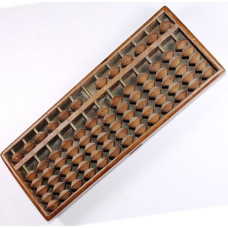Cet abaque est en très bon état et fonctionne à merveille. On peut remarquer la numération japonaise gravée à la main sur les six premières et les six dernières positions de la barre de séparation.
Les bâtonnets en métal, qui sont fixés en haut et en bas du cadre et traversent verticalement la barre de séparation, sont appelés tiges et servent à déplacer les boules. Chaque tige représente un des chiffres du nombre. Pour procéder au calcul, on doit choisir une tige comme le nombre des unités. En comptant à partir de cette tige vers la gauche, ce sont respectivement les dizaines, les centaines, les milliers, les dizaines de mille…et à droite du nombre, ce sont les dixièmes, les centièmes et ainsi de suite. Les bouliers comptent en général 9 à 15 tiges. Les étudiants en finance et en comptabilité utilisent de préférence un boulier spécial qui compte 13 ou 17 tiges.
En termes de valeur, une boule supérieure représente cinq unités et une boule inférieure représente une unité.
Dimensions en cm et poids: 28,5 L x 11 H x 4 Ép. - 550 g (780 g avec emballage d'envoi)
Boulier Soroban japonais en bois, 13 rangées, début XXe s.
- Modèle : Objets insolites
- Disponibilité : 1
-
€ 60.00
Etiquettes : abaque, boulier, soroban, japon, chine, abacus, numération, compter, calculs, calculer, additionner, multiplier, soustraire, boules, billes, unités, dizaines, centaines, milliers, comptabilité, université



